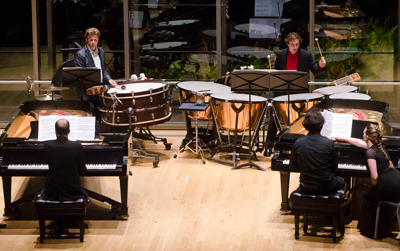by Daniel Hathaway

Stravinsky’s orchestration is rich with color and vibrant with rhythm. The two-piano version necessarily sheds a lot of symphonic hues (something that’s obvious from the opening bars, when that strained high bassoon solo gets translated to the keyboard), but the visceral quality of the composer’s groundbreaking rhythms only becomes enhanced on the piano. Add to that five timpani, bass drum, cymbals, gongs and other instruments culled from the orchestral batterie, and the effect is super-thrilling.
Weiss and Porat have mastered Stravinsky’s demanding score and played it fearlessly — and flawlessly. Christian and Cohen — Cohen especially on the timpani — had some remarkable material to cover and daunting patches of rests to count out. No need for a conductor: these four propelled their way through the score with confidence and verve and crafted a breathtaking performance that had the audience out of its seats in seconds at the end.
The evening opened with Joseph Haydn’s late and continuously surprising Trio in E, played by violinist Noah Bendix-Balgley, cellist Tanya Ell and pianist Matan Porat (who wasn’t resting up for the Stravinsky!) Novel in its structure and voicing, the trio was written shortly after 1795 when Haydn, then 63, had returned from his second visit to England.
Like Beethoven’s early piano trios, Haydn’s E-major work favors the pianist, here with elegant elaborations of melodic lines and a strangely compelling two-part invention structure in the Allegretto which shares its material back and forth with the other instruments. Bendix-Balgley, Ell and Porat gave it a masterfully nuanced reading.
The big middle piece, if not the thematic centerpiece of the evening, was Brahms’s Clarinet Quintet, op. 115, which brought the festival’s artistic directors, Franklin and Diana Cohen into collaboration with violinist Yehonatan Berick, violist Dimitri Murrath and cellist Robert deMaine.
Brahms is reported to have said, after hearing the clarinetist who inspired no fewer than four of his works featuring that instrument, “It is impossible to play the clarinet better than Herr Mühlfield does here.” At the time, perhaps, but Brahms would doubtless have been deeply moved by Saturday evening’s performance. Frank Cohen is a first-class chamber musician who can produce a wide range of timbres and colors, and who knows exactly when to assert himself and when to merge into the ensemble. On Saturday, he had a dream team of colleagues who shared those skills and sensitivities.
The Brahms quintet is long but, interestingly, its movements become increasingly shorter and less discursive as the piece progresses. The respite of a scherzo-like third movement and the stanza-like theme and variations of the finale helped move things along even for those who can find this piece glorious but long-winded.
Elegant Haydn, golden Brahms, thrilling Stravinsky, all brilliantly played. Riot was yet another artistic triumph for ChamberFest Cleveland and a model for interestingly varied programming.
Photo by Gary Adams.
Published on ClevelandClassical.com July 2, 2013
Click here for a printable version of this article.



